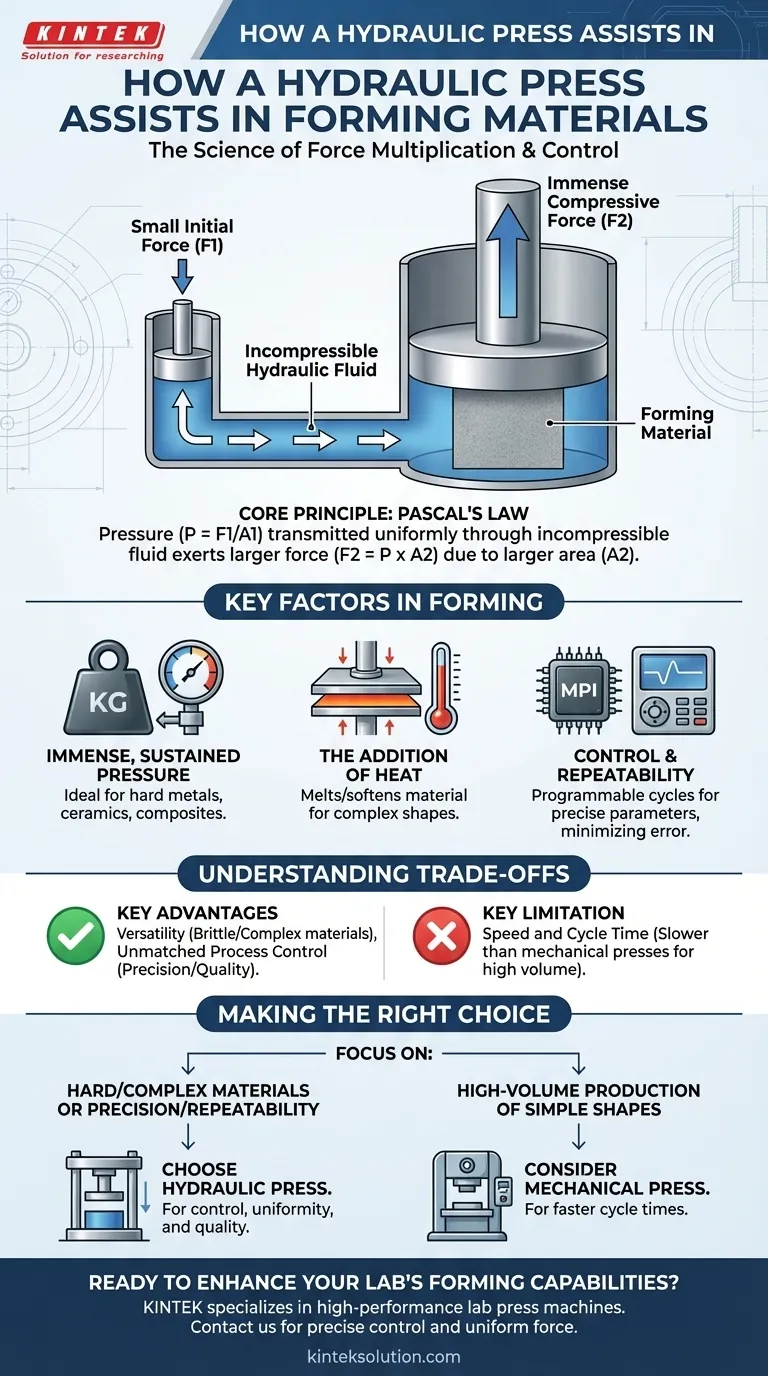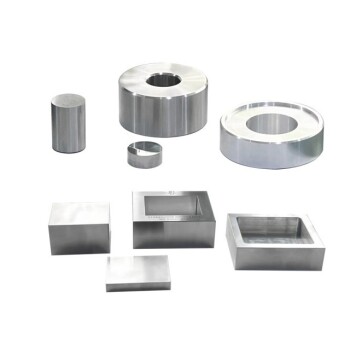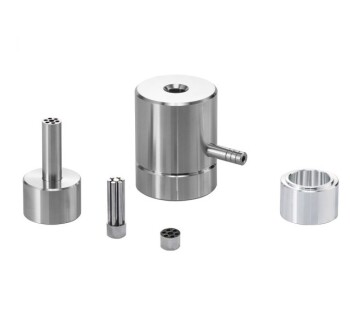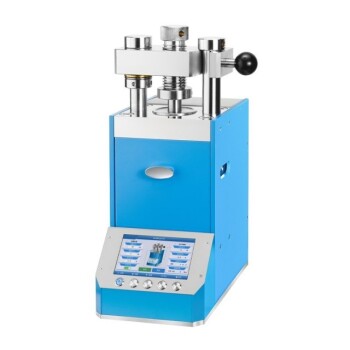At its core, a hydraulic press forms materials by using an incompressible fluid to amplify a small initial force into an immense compressive force. Based on Pascal's Law, this system transmits pressure uniformly throughout the fluid, allowing it to exert a powerful, controlled, and evenly distributed force onto a material, shaping it into a desired form without fracturing it.
The true value of a hydraulic press isn't just its raw power; it's the ability to apply that power with exceptional control and uniformity. This unique combination makes it indispensable for forming the advanced, sensitive, and high-strength materials required by modern industry.
The Core Principle: Force Multiplication via Pascal's Law
To understand how a hydraulic press works, you must first understand its foundational principle: Pascal's Law. This states that pressure applied to a confined, incompressible fluid is transmitted equally in all directions throughout the fluid.
How It Works: The Two-Cylinder System
A basic hydraulic press consists of two interconnected cylinders of different sizes, each sealed with a piston. A small mechanical force is applied to the piston in the smaller cylinder.
This action pressurizes the hydraulic fluid. Because the pressure is transmitted equally, the same pressure is exerted on the much larger piston in the second cylinder. Since force equals pressure multiplied by area, the larger surface area of the second piston multiplies the initial force significantly.
The Role of Hydraulic Fluid
The system relies on a specialized hydraulic fluid, typically an oil. This fluid is chosen for two key properties: it is virtually incompressible and it provides excellent lubrication.
This ensures that energy is not lost to fluid compression and that the force is transferred with maximum efficiency and smoothness.
Uniform Pressure Application
This method of force transmission guarantees that pressure is applied evenly across the entire surface of the material being formed. This uniformity is critical for preventing defects like air bubbles, incomplete mold filling, or stress fractures, ensuring a high-quality final product.
Key Factors in the Forming Process
The effectiveness of a hydraulic press goes beyond its basic mechanism. Several factors work together to enable the precise formation of a wide range of materials.
Immense, Sustained Pressure
The primary advantage is the ability to generate and hold an extremely high level of force for a sustained period. This makes hydraulic presses ideal for forming hard materials like metals, ceramics, and advanced composites that require significant pressure to change their shape.
The Addition of Heat
For many applications, especially in laboratories or with powdered materials, the process combines both pressure and heat. The press platens are heated, melting or softening the material, while the hydraulic cylinder provides the pressure to compress it into the desired shape and density.
Control and Repeatability
Modern automatic hydraulic presses offer a level of precision that is critical for high-performance applications in the aerospace, automotive, and medical industries.
Microprocessor controls allow users to pre-program complex operation cycles with multiple segments of varying pressure and duration. This programmability ensures that every sample is prepared with exact, repeatable parameters, minimizing operator error and maximizing consistency.
Understanding the Trade-offs
While powerful, hydraulic presses are not the universal solution for every forming application. Understanding their limitations is key to making an informed decision.
Key Advantage: Versatility and Power
The ability to deliver a consistent, controlled force makes the hydraulic press uniquely suited for materials that are brittle, complex, or require deep drawing. It can handle forming, molding, and pressing of everything from superalloys to powdered ceramics.
Key Advantage: Unmatched Process Control
For any application where precision and quality are paramount, the hydraulic press is superior. The ability to precisely control the force, speed, and duration of the press stroke is unmatched by purely mechanical systems.
Key Limitation: Speed and Cycle Time
The primary trade-off for this control and power is speed. Moving fluid to build pressure is inherently slower than the direct mechanical action of a stamping or mechanical press. For high-volume production of simple parts, a mechanical press often provides a faster cycle time.
Making the Right Choice for Your Goal
Selecting the correct forming method depends entirely on your material and your desired outcome.
- If your primary focus is forming hard, brittle, or complex materials: The sustained, uniform pressure of a hydraulic press is essential to prevent fractures and ensure complete formation.
- If your primary focus is high-precision and repeatability for advanced applications: An automatic hydraulic press with programmable cycles is the only way to guarantee the necessary process control.
- If your primary focus is high-volume production of simple shapes: You must weigh the superior control of a hydraulic press against the potentially faster cycle times of a mechanical press.
By mastering the controlled application of immense force, the hydraulic press empowers you to reliably shape the most demanding materials.
Summary Table:
| Key Aspect | Description |
|---|---|
| Core Principle | Uses Pascal's Law to amplify force via hydraulic fluid for uniform pressure. |
| Key Advantages | Immense force, precise control, repeatability, and versatility in material forming. |
| Common Applications | Forming metals, ceramics, composites; used in aerospace, automotive, and medical industries. |
| Limitations | Slower cycle times compared to mechanical presses for high-volume production. |
Ready to enhance your laboratory's material forming capabilities? KINTEK specializes in high-performance lab press machines, including automatic lab presses, isostatic presses, and heated lab presses, designed to deliver precise control and uniform force for demanding materials like metals and ceramics. Our solutions ensure repeatable results, reduce operator error, and boost efficiency in research and development. Contact us today to discuss how we can support your specific needs and help you achieve superior outcomes!
Visual Guide

Related Products
- Manual Heated Hydraulic Lab Press with Integrated Hot Plates Hydraulic Press Machine
- Automatic Laboratory Hydraulic Press Lab Pellet Press Machine
- Manual Laboratory Hydraulic Press Lab Pellet Press
- Laboratory Hydraulic Press 2T Lab Pellet Press for KBR FTIR
- Automatic High Temperature Heated Hydraulic Press Machine with Heated Plates for Lab
People Also Ask
- What makes laboratory presses durable and consistent? Key Design and Control Insights
- What factors should be considered when choosing a hydraulic press for laboratory applications? Optimize Your Lab Efficiency
- What factors determine the choice of hydraulic press for a laboratory? Optimize Your Lab's Efficiency and Precision
- What are the key features of lab presses? Unlock Precision Force and Heat Control for Your Lab
- Why is a heated hydraulic press considered a critical tool in research and production environments? Unlock Precision and Efficiency in Material Processing



















